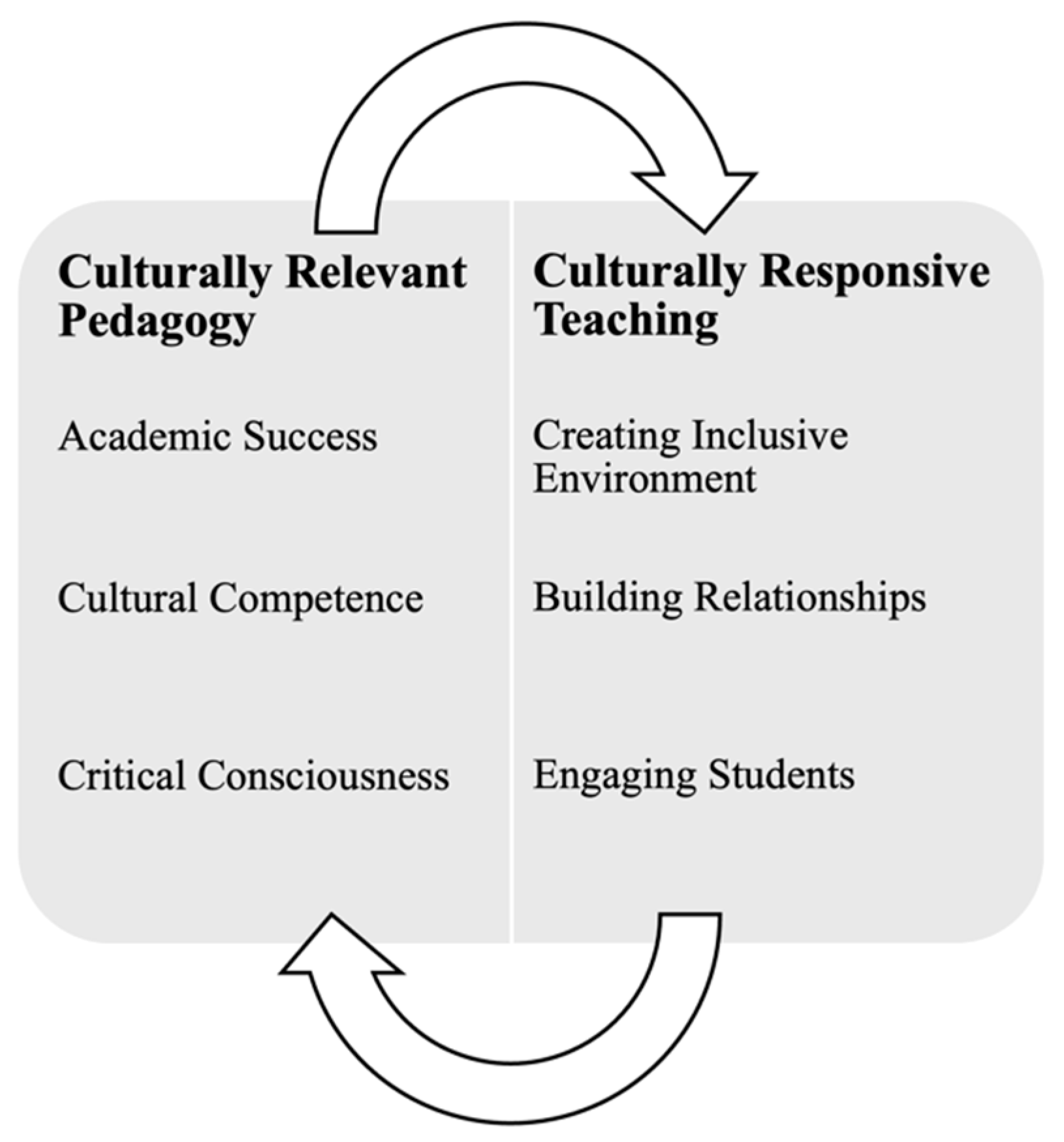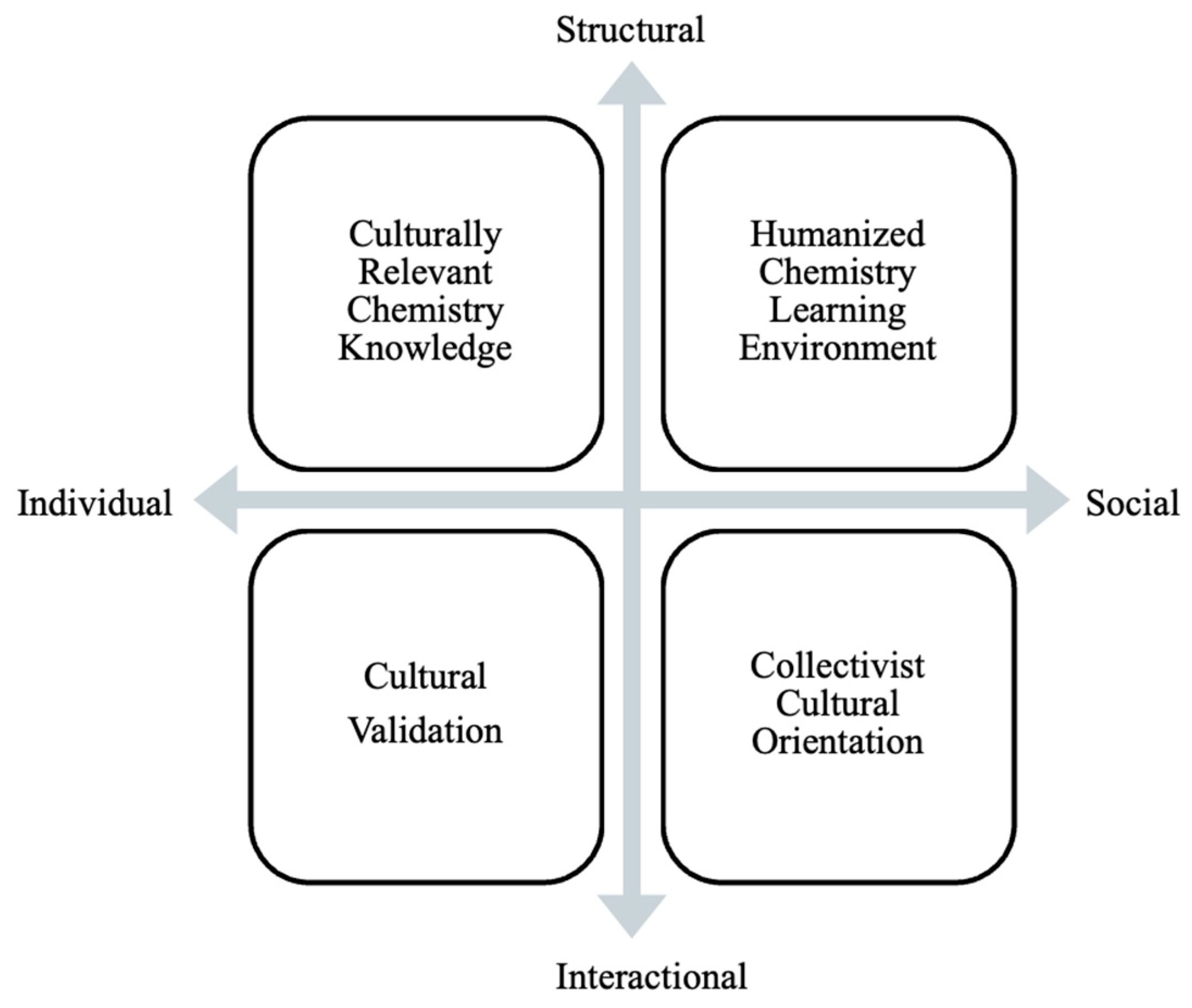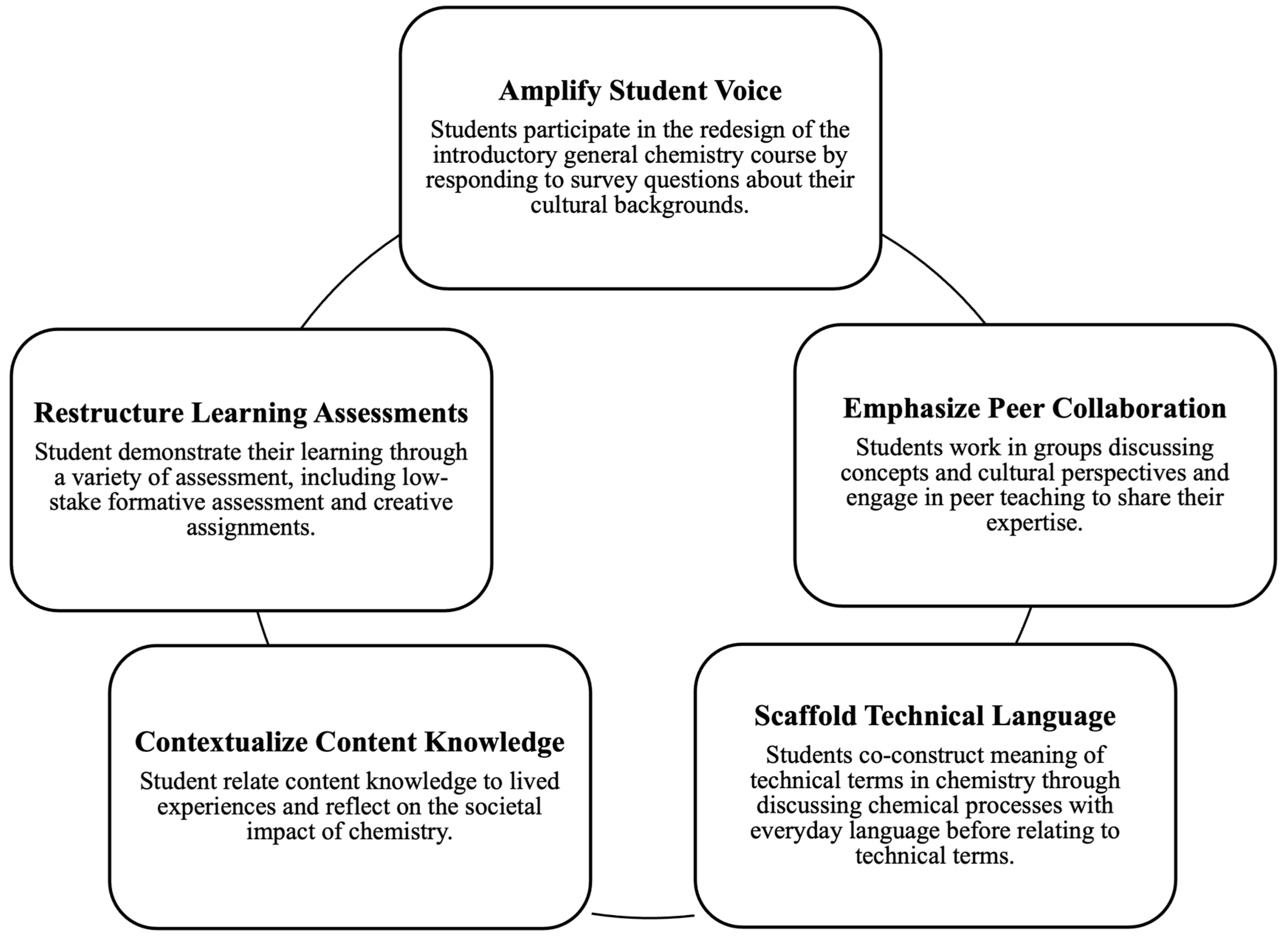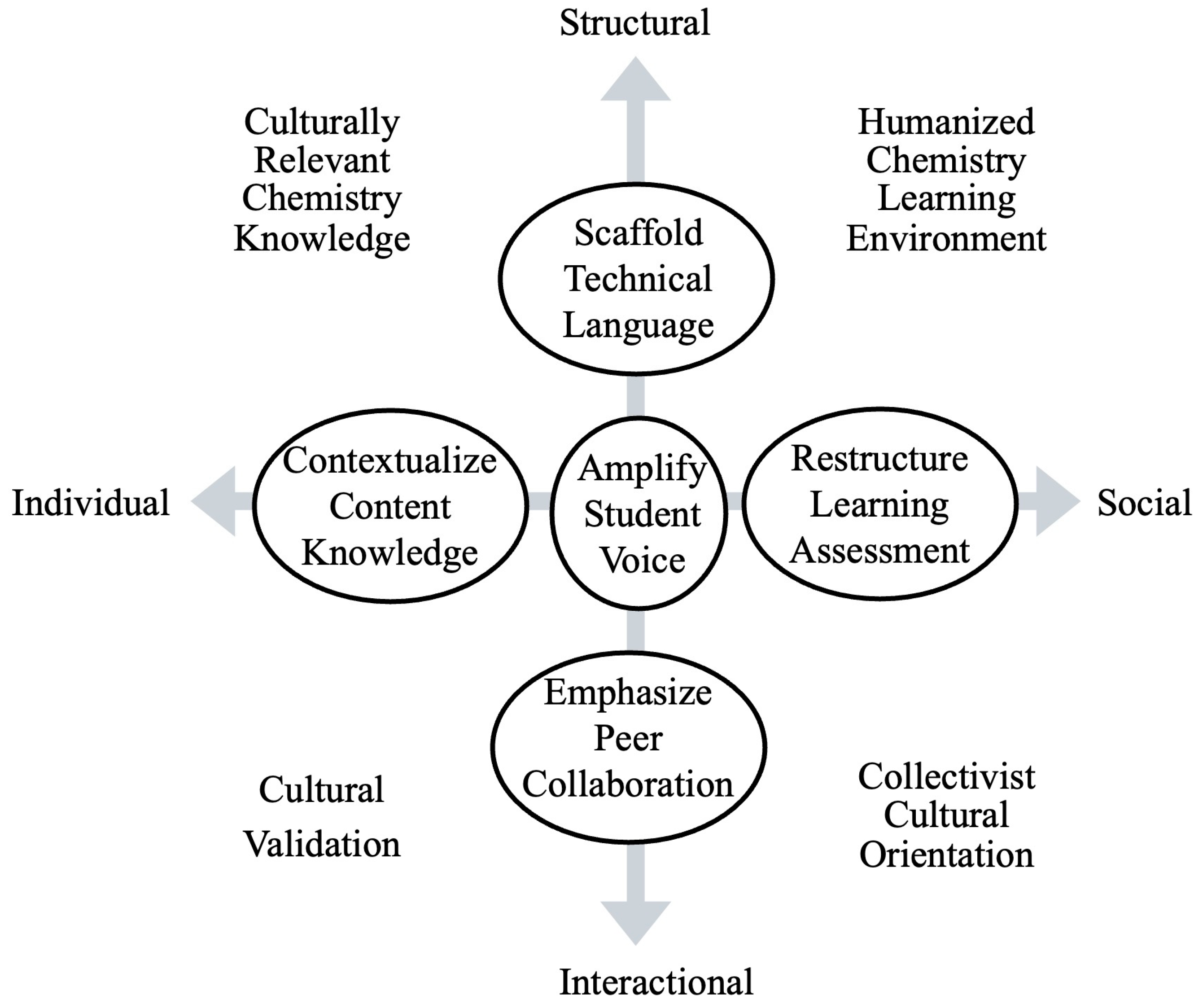Re-Envisioning Classroom Culture in an Introductory General Chemistry Course: Description of a Course Redesign Project
Abstract
1. Introduction
1.1. Culturally Relevant Pedagogy and Culturally Responsive Teaching
1.2. CRP and CRT in Chemistry Courses
1.3. Framework for Re-Envision Chemistry Classroom Culture
2. Approach to Course Redesign
2.1. Entry Points for Course Redesign
2.1.1. Amplify Student Voice
2.1.2. Emphasize Peer Collaboration
2.1.3. Scaffold Technical Language
2.1.4. Contextualize Content Knowledge
2.1.5. Restructure Learning Assessment
3. Discussion
4. Future Work
Supplementary Materials
Author Contributions
Funding
Conflicts of Interest
References
- Afitska, O. (2016). Scaffolding learning: Developing materials to support the learning of science and language by non-native English-speaking students. Innovations in Language Learning and Teaching, 10(2), 75–89. [Google Scholar] [CrossRef]
- Aguirre, J. M., & Del Rosario Zavala, M. (2013). Making culturally responsive mathematics teaching explicit: A lesson analysis tool. Pedagogy: International Journal, 8(2), 163–190. [Google Scholar] [CrossRef]
- Aoki, E., Rastede, E., & Gupta, A. (2022). Teaching sustainability and environmental justice in undergraduate chemistry courses. Journal of Chemical Education, 99(1), 283–290. [Google Scholar] [CrossRef]
- Bardi, M., Koone, T., Mewaldt, S., & O’Connor, K. (2011). Behavioral and physiological correlates of stress related to examination performance in college chemistry students. Stress, 14(5), 557–566. [Google Scholar] [CrossRef]
- Bozalek, V., Bayat, A., Gachago, D., Motala, S., & Mitchell, V. (2018). A pedagogy of response-ability. In Socially just pedagogies in higher education: Critical posthumanist and new feminist materialist perspectives (pp. 97–112). Bloomsbury Publishing. [Google Scholar]
- Broman, K., & Parchmann, I. (2014). Students’ application of chemical concepts when solving chemistry problems in different contexts. Chemistry Education Research and Practice, 15(4), 516–529. [Google Scholar] [CrossRef]
- Civitillo, S., Juang, L. P., Badra, M., & Schachner, M. K. (2019). The interplay between culturally responsive teaching, cultural diversity beliefs, and self-reflection: A multiple case study. Teaching and Teacher Education, 77, 341–351. [Google Scholar] [CrossRef]
- Estrada, M., Burnett, M., Campbell, A. G., Campbell, P. B., Denetclaw, W. F., Gutiérrez, C. G., Hurtado, S., John, G. H., Matsui, J., McGee, R., Okpodu, C. M., Robinson, T. J., Summers, M. F., Werner-Washburne, M., & Zavala, M. (2016). Improving underrepresented minority student persistence in STEM. CBE—Life Sciences Education, 15(3), es5. [Google Scholar] [CrossRef] [PubMed]
- Ferri, J. K., & White, R. S. (2024). Culturally relevant STEM (CReST): An integrated support curriculum for high school chemistry and world history. Education Sciences, 14(2), 182. [Google Scholar] [CrossRef]
- Flores, G. M., Bañuelos, M., & Harris, P. R. (2024). “What are you doing here?”: Examining minoritized undergraduate student experiences in STEM at a minority-serving institution. Journal of STEM Education Research, 7(2), 181–204. [Google Scholar] [CrossRef]
- Gay, G. (2008). Culturally responsive teaching: Theory, research, and practice. Teachers College Press. [Google Scholar]
- Gezer-Templeton, P. G., Mayhew, E. J., Korte, D. S., & Schmidt, S. J. (2017). Use of exam wrappers to enhance students’ metacognitive skills in a large introductory food science and human nutrition course. Journal of Food Science Education, 16(1), 28–36. [Google Scholar] [CrossRef]
- Goethe, E. V., & Colina, C. M. (2018). Taking advantage of diversity within the classroom. Journal of Chemical Education, 95(2), 189–192. [Google Scholar] [CrossRef]
- Hodges, L. C., Beall, L. C., Anderson, E. C., Carpenter, T. S., Cui, L., Feeser, E., Gierasch, T., Nanes, K. M., Perks, H. M., & Wagner, C. (2020). Effect of exam wrappers on student achievement in multiple, large STEM courses. Journal of College Science Teaching, 50(1), 69–79. [Google Scholar] [CrossRef]
- Johnson, A., & Elliott, S. (2020). Culturally relevant pedagogy: A model to guide cultural transformation in STEM departments. Journal of Microbiology and Biology Education, 21(1), 5. [Google Scholar] [CrossRef]
- Jumarito, E., & Nabua, E. (2021). Integrating indigenous practices in chemistry instructional material for a culturally responsive STEM curriculum. Asia Research Network Journal of Education, 4, 1–15. [Google Scholar]
- Jung, K. G. (2019). Learning to scaffold science academic language: Lessons from an instructional coaching partnership. Research in Science Education, 49(4), 1013–1024. [Google Scholar] [CrossRef]
- Karacop, A. (2017). The effects of using the jigsaw method based on the cooperative learning model in undergraduate science laboratory practices. Universal Journal of Educational Research, 5(3), 420–434. [Google Scholar] [CrossRef]
- Ladson-Billings, G. (1995). Toward a theory of culturally relevant pedagogy. American Educational Research Journal, 32(3), 465–491. [Google Scholar] [CrossRef]
- Ladson-Billings, G. (2006). From the achievement gap to the education debt: Understanding achievement in U.S. schools. Educational Researcher, 35(7), 3–12. [Google Scholar] [CrossRef]
- Ladson-Billings, G. (2021). Three decades of culturally relevant, responsive, and sustaining pedagogy: What lies ahead? The Educational Forum, 85(4), 351–354. [Google Scholar] [CrossRef]
- Luzyanin, K. V. (2024). Workshops redeveloped: Group work to nurture a more inclusive learning environment. Development in Academic Practice (Special), 2024, 9–17. [Google Scholar] [CrossRef]
- National Academies of Sciences, Engineering, and Medicine. (2021). Call to action for science education: Building opportunity for the future. The National Academies Press. [Google Scholar]
- National Academy of Sciences, National Academy of Engineering & Institute of Medicine. (2010). Rising above the gathering storm, revisited: Rapidly approaching category 5. The National Academies Press. [Google Scholar]
- Nolan, J. M., Hanley, B. G., DiVietri, T. P., & Harvey, N. A. (2018). She who teaches learns: Performance benefits of a jigsaw activity in a college classroom. School Teaching and Learning Psychology, 4(2), 93. [Google Scholar] [CrossRef]
- Oladejo, A. I., Okebukola, P. A., Olateju, T. T., Akinola, V. O., Ebisin, A., & Dansu, T. V. (2022). In search of culturally responsive tools for meaningful learning of chemistry in Africa: We stumbled on the culturo-techno-contextual approach. Journal of Chemical Education, 99(8), 2919–2931. [Google Scholar] [CrossRef]
- Olson, S., & Riordan, D. G. (2012). Engage to excel: Producing one million additional college graduates with degrees in science, technology, engineering, and mathematics. Report to the President. Executive Office of the President. [Google Scholar]
- Pereira Gomes, J., Silva de Lima, M., & Dantas Filho, F. F. (2024). Integrating local knowledge on cactus pear from Brazilian northeastern communities for culturally responsive chemistry teaching. Journal of Chemical Education, 101(8), 3578–3583. [Google Scholar] [CrossRef]
- Pickering, C., Lopez, M., Craft, E., Belknap, S., VanIngen-Dunn, C., Miller McNeill, L., & Rodriguez, J. (2023, June 25–28). Theory to practice: Faculty professional development to integrate culturally responsive pedagogy and practices in STEM education to improve success of underserved students in STEM. ASEE Annual Conference & Exposition Proceedings, Baltimore, MD, USA. [Google Scholar] [CrossRef]
- President’s Council of Advisors on Science and Technology. (2021). Industries of the future institutes: A new model for American science and technology leadership. Executive Office of the U.S. President. [Google Scholar]
- Rahmawati, Y., Ridwan, A., & Nurbaity, N. (2017). Should we learn culture in the chemistry classroom? Integration of ethnochemistry in culturally responsive teaching. AIP Conference Proceedings, 1868(1), 030009. [Google Scholar] [CrossRef]
- Rempel, B. P., Dirks, M. B., & McGinitie, E. G. (2021). Two-stage testing reduces student-perceived exam anxiety in introductory chemistry. Journal of Chemical Education, 98(8), 2527–2535. [Google Scholar] [CrossRef]
- Rendon, L. I. (1994). Validating culturally diverse students: Toward a new model of learning and student development. Innovative Higher Education, 19, 33–51. [Google Scholar] [CrossRef]
- Rodenbough, P. P., & Manyilizu, M. C. (2019). Developing and piloting culturally relevant chemistry pedagogy: Computer-based VSEPR and unit cell lesson plans from collaborative exchange in East Africa. Journal of Chemical Education, 96(6), 1273–1277. [Google Scholar] [CrossRef]
- Roque-Peña, J. (2024). Student engagement in an introductory chemistry course at a Hispanic-serving institution: An exploratory case study. Journal of Chemical Education, 101(8), 2966–2975. [Google Scholar] [CrossRef]
- Sanders Johnson, S. (2022). Embracing culturally relevant pedagogy to engage students in chemistry: Celebrating Black women in the whiskey and spirits industry. Journal of Chemical Education, 99(1), 428–434. [Google Scholar] [CrossRef]
- Scanlon, E., Legron-Rodriguez, T., Schreffler, J., Ibadlit, E., Vasquez, E., & Chini, J. J. (2018). Postsecondary chemistry curricula and universal design for learning: Planning for variations in learners’ abilities, needs, and interests. Chemistry Education Research and Practice, 19(4), 1216–1239. [Google Scholar] [CrossRef]
- Schmitt, K. R., Larsen, E. A., Miller, M., Badawy, A. H. A., Dougherty, M., Sharma, A. T., Hrapczynski, K., Andrew, A., Robertson, B., Williams, A., Kramer, S., & Benson, S. (2013). A survey tool for assessing student expectations early in a semester. Journal of Microbiology & Biology Education, 14(2), 255–257. [Google Scholar]
- Sjöström, J., & Talanquer, V. (2014). Humanizing chemistry education: From simple contextualization to multifaceted problematization. Journal of Chemical Education, 91(8), 1125–1131. [Google Scholar] [CrossRef]
- Spencer, J. L., Maxwell, D. N., Erickson, K. R. S., Wall, D., Nicholas-Figueroa, L., Pratt, K. A., & Shultz, G. V. (2022). Cultural relevance in chemistry education: Snow chemistry and the Iñupiaq community. Journal of Chemical Education, 99(1), 363–372. [Google Scholar] [CrossRef]
- Stoddard, S. V. (2022). The benefits of enlightenment: A strategic pedagogy for strengthening sense of belonging in chemistry classrooms. Education Sciences, 12(7), 498. [Google Scholar] [CrossRef]
- Symons, C. (2021). Instructional practices for scaffolding emergent bilinguals’ comprehension of informational science texts. Pedagogy: International Journal, 16(1), 62–80. [Google Scholar] [CrossRef]
- Tang, K. S. (2019). The role of language in scaffolding content and language integration in CLIL science classrooms. Journal of Immersion and Content-Based Language Education, 7(2), 315–328. [Google Scholar] [CrossRef]
- Tarhan, L., Ayyıldız, Y., Ogunc, A., & Sesen, B. A. (2013). A jigsaw cooperative learning application in elementary science and technology lessons: Physical and chemical changes. Research in Science & Technological Education, 31(2), 184–203. [Google Scholar]
- Tshojay, P., & Giri, N. (2021). Contextualized approach in teaching chemistry: The perspectives and practices of teachers and students. International Journal of Applied Chemistry and Biological Sciences, 2(4), 78–91. [Google Scholar]
- Urban, S., Brkljaca, R., Cockman, R., & Rook, T. (2017). Contextualizing learning chemistry in first-year undergraduate programs: Engaging industry-based videos with real-time quizzing. Journal of Chemical Education, 94(7), 873–878. [Google Scholar] [CrossRef]
- Vargas, E. A., Scherer, L. A., Fiske, S. T., Barabino, G. A., & National Academies of Sciences, Engineering, and Medicine. (2023). Population data and demographics in the United States. In Advancing antiracism, diversity, equity, and inclusion in STEMM organizations: Beyond broadening participation. National Academies Press. [Google Scholar]
- White, K. N., Vincent-Layton, K., & Villarreal, B. (2021). Equitable and inclusive practices designed to reduce equity gaps in undergraduate chemistry courses. Journal of Chemical Education, 98(2), 330–339. [Google Scholar] [CrossRef]
- Willson-Conrad, A., & Kowalske, M. G. (2018). Using self-efficacy beliefs to understand how students in a general chemistry course approach the exam process. Chemistry Education Research and Practice, 19(1), 265–275. [Google Scholar] [CrossRef]
- Winstead, A. J., McCarthy, P. C., Rice, D. S., & Nyambura, G. W. (2022). Linking chemistry to community: Integration of culturally responsive teaching into general chemistry I laboratory in a remote setting. Journal of Chemical Education, 99(1), 402–408. [Google Scholar] [CrossRef] [PubMed]
- Xie, J., & Ferguson, Y. (2024). STEM faculty’s perspectives on adopting culturally responsive pedagogy. Teaching in Higher Education, 29(5), 1215–1233. [Google Scholar] [CrossRef]




Disclaimer/Publisher’s Note: The statements, opinions and data contained in all publications are solely those of the individual author(s) and contributor(s) and not of MDPI and/or the editor(s). MDPI and/or the editor(s) disclaim responsibility for any injury to people or property resulting from any ideas, methods, instructions or products referred to in the content. |
© 2025 by the authors. Licensee MDPI, Basel, Switzerland. This article is an open access article distributed under the terms and conditions of the Creative Commons Attribution (CC BY) license (https://creativecommons.org/licenses/by/4.0/).
Share and Cite
Wang, S.; Bussey, T.J. Re-Envisioning Classroom Culture in an Introductory General Chemistry Course: Description of a Course Redesign Project. Educ. Sci. 2025, 15, 307. https://doi.org/10.3390/educsci15030307
Wang S, Bussey TJ. Re-Envisioning Classroom Culture in an Introductory General Chemistry Course: Description of a Course Redesign Project. Education Sciences. 2025; 15(3):307. https://doi.org/10.3390/educsci15030307
Chicago/Turabian StyleWang, Song, and Thomas J. Bussey. 2025. "Re-Envisioning Classroom Culture in an Introductory General Chemistry Course: Description of a Course Redesign Project" Education Sciences 15, no. 3: 307. https://doi.org/10.3390/educsci15030307
APA StyleWang, S., & Bussey, T. J. (2025). Re-Envisioning Classroom Culture in an Introductory General Chemistry Course: Description of a Course Redesign Project. Education Sciences, 15(3), 307. https://doi.org/10.3390/educsci15030307





